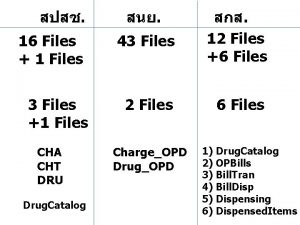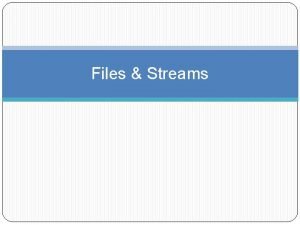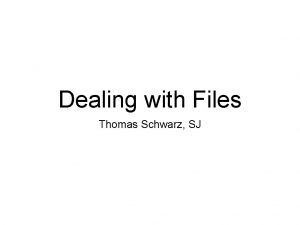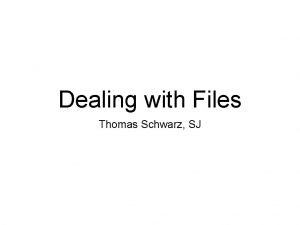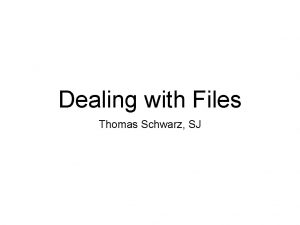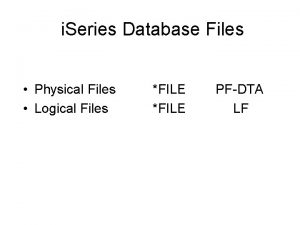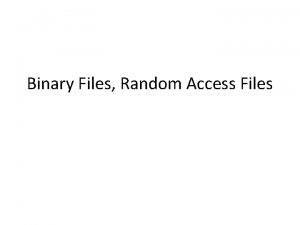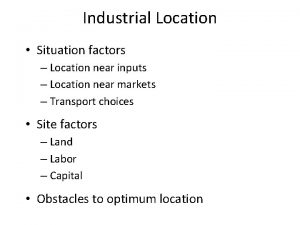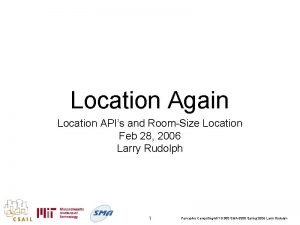Checking the Server Location of Server Files on



















- Slides: 19

Checking the Server

Location of Server Files on the Virtual Machine • On your virtual machine: – The Tomcat servlet engine is in /usr/local/javadev/apache/tomcat-5. 5. 12 (this is the value of $CATALINA_HOME) – The BES, data handlers and related source files are in /usr/local/src. The BES has been built and installed in /usr/local/ ($prefix) – The OLFS web archive file is $CATALINA_HOME/webapps/opendap. war – BES: bes. conf, found at $prefix/etc/bes. conf – OLFS: olfs. xml and catalog. xml, found at $CATALINA_HOME/content/opendap

Background: Starting the Server • Start the BES (back-end data processing component) • Use bescmdln to verify it’s working • Start Tomcat: This automatically starts all installed servlets – Servlets are installed by copying the. war file to the servlet’s webapps directory • Verify it’s working using a web browser

Start the BES

Verify the BES is running

Start Tomcat & the OLFS • Typical steps: – Unpack the olfs jar-file – Copy the opendap. war file to Tomcat’s webapps directory – Start Tomcat • Since all but the last step has been done already, start Tomcat: – /usr/local/javadev/apache-tomcat-5. 5. 12/bin/startup. sh

…terminal view

Verify Tomcat is running http: //localhost: 8080

…and Hyrax http: //localhost: 8080/opendap

Troubleshooting • The getdap command line client – Can request any of the DAP response objects – Can act as a simple, generic web client • When even getdap cannot diagnose a problem, use telnet!

Troubleshooting with getdap • Use getdap to get – The DAS, DDS, Data, DDX – Version information • Use telnet to view the raw HTTP response • If the server times out too quickly, use expect to control telnet

Use the ‘-a’ option to get a DAS response Also provide a valid URL http: //localhost: 8080/opendap/data/nc/fnoc 1. nc

Use the ‘-d’ option to get a DDS response

…or drop the -d option and append the ‘. dds’ suffix

Use the ‘-D’ (data) and ‘-c’ (constraint) options to get a data response. A constraint expression with just one variable. We got this from the DDS above

This constraint is asking for the values of ‘time’ between indexes 2 and 6 (every second value).

Appending the string ‘version’ to the server root name requests version information. It comes back in an XML document.

Telnet reveals all • Use telnet to pass HTTP commands directly to the ‘opendap’ web application • Open the connection using the host name and port number • Use the ‘GET’ command, the pathname part of the URL including the DAP request extension and ‘HTTP/1. 1’ or ‘HTTP/1. 0’ • Often you will need to supply a ‘Host: <name>’ header • A blank line.

Connect to the Tomcat or Apache server GET <pathname> HTTP/1. 1 (or 1. 0) - hit return quickly! Host: header is important for a virtual server Here’s the payoff - we can see all of the headers set by both the web app and the server, plus the response. Be cautious with data responses because they are binary and will mess up your terminal session. Note the HTTP 1. 1 chunking counts (c 5 and 0)
 Dot powai files are binary files
Dot powai files are binary files Cjis security training
Cjis security training Cjis meaning
Cjis meaning A cross country skier moves from location a
A cross country skier moves from location a Regional factors for location planning
Regional factors for location planning Eve online servers
Eve online servers ưu thế lai là gì
ưu thế lai là gì Hệ hô hấp
Hệ hô hấp Kể tên các môn thể thao
Kể tên các môn thể thao Tư thế ngồi viết
Tư thế ngồi viết Hình ảnh bộ gõ cơ thể búng tay
Hình ảnh bộ gõ cơ thể búng tay Cái miệng bé xinh thế chỉ nói điều hay thôi
Cái miệng bé xinh thế chỉ nói điều hay thôi Mật thư anh em như thể tay chân
Mật thư anh em như thể tay chân Tư thế ngồi viết
Tư thế ngồi viết V cc cc
V cc cc Voi kéo gỗ như thế nào
Voi kéo gỗ như thế nào Thẻ vin
Thẻ vin Thơ thất ngôn tứ tuyệt đường luật
Thơ thất ngôn tứ tuyệt đường luật Các châu lục và đại dương trên thế giới
Các châu lục và đại dương trên thế giới Hươu thường đẻ mỗi lứa mấy con
Hươu thường đẻ mỗi lứa mấy con




















